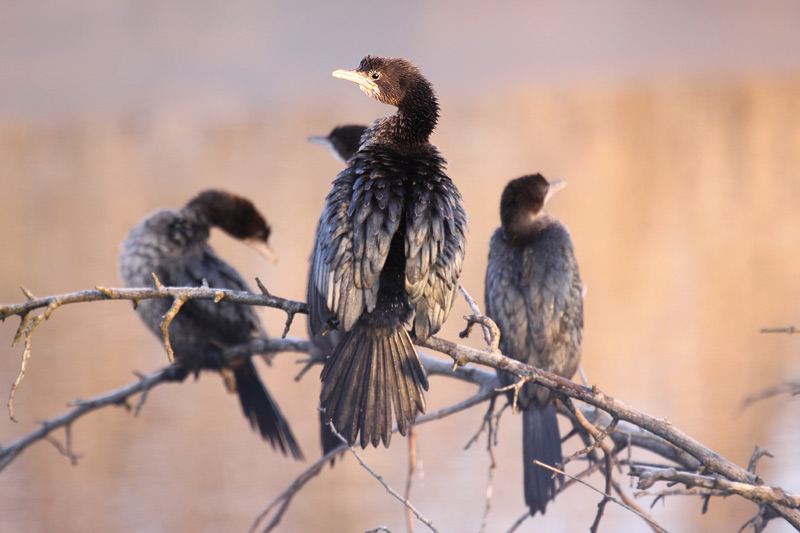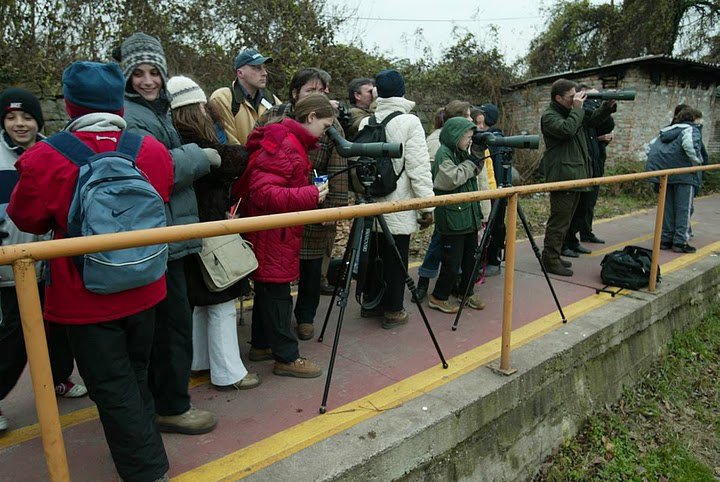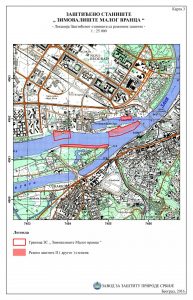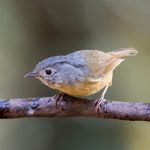
It all started during the icy February of 1996. The night temperatures in Belgrade, Serbia, were already below minus 10 Celsius / 14 degrees Fahrenheit for two weeks. Everything was frozen solid and pack ice was floating down the Danube. Hiding from the elements at the riverbank, I was sitting in a Yugo and staring at the murky sky. Whenever the windscreen got frozen, I could not afford to turn the engine on due to petrol shortages (during the UN embargo on the import of fuel to the former Yugoslavia), so I would turn on a mini camping gas stove to defrost the windows and warm up my cocoon, keeping one eye at the sky and the other at the flames, to make sure they do not catch the seat. What was I doing there? Back in those days, Pygmy Cormorants Microcarbo pygmeus were considered Vulnerable by the IUCN Red List and were quite uncommon, having just returned to the city after half a century of absence.
Up to the mid-20th century, Pygmy Cormorant was a common breeding species of wetlands around Belgrade until most wetlands were drained and the birds were lost, at one moment – from the entire territory of Serbia. With the construction of the huge Iron Gates dam on the Danube, the birds returned to breed in newly flooded river islands. And in the late 1980s they returned to Belgrade, too, but only to overwinter within the city. In recent years, the overwintering population in Belgrade is around 4,000 Pygmy Cormorants, representing 2 percent of the global population and over 5 percent of the European population.
 One of the very first Pygmy Cormorant promotions: League for Ornithological Action organised this roost watch in December 2004. Photo Milan Obradovic.
One of the very first Pygmy Cormorant promotions: League for Ornithological Action organised this roost watch in December 2004. Photo Milan Obradovic.
In the last few hours of daylight, Pygmy Cormorants commute from the river Danube back to their roost on the Sava River, to several willow groves by the Ada Ciganlija Island, using the rivers as the flight corridors. Therefore, you can observe them in their hundreds and thousands if you spend the last hour of the day observing the flight corridor and distinguishing distant black Pygmy Cormorant dots from other equally distant and black Rook and Jackdaw dots, all of them melting into tree crowns as the sunset thickens. The biggest threat to Pygmy Cormorants overwintering in Belgrade is urbanization of its riverbanks and destruction of remaining willow groves, which sparked the 2009 initiative by the Belgrade Land Development Public Agency, League for Ornithological Action (a local NGO) and the Institute for Nature Conservation of Serbia to protect the remaining roosting sites of this species.
The biggest threat to Pygmy Cormorants overwintering in Belgrade is urbanization of its riverbanks and destruction of remaining willow groves, which sparked the 2009 initiative by the Belgrade Land Development Public Agency, League for Ornithological Action (a local NGO) and the Institute for Nature Conservation of Serbia to protect the remaining roosting sites of this species.
By both Serbian legislation and the Bern Convention on the Conservation of European Wildlife and Natural Habitats, Pygmy Cormorant is a strictly protected species. In the European Union, they are included on the Annex I of the Birds Directive and their habitats are therefore potential Natura2000 ecological network sites.
For almost 20 years during which the League for Ornithological Action had been following the Pygmy Cormorant in Belgrade, the maximum number was recorded in the winter of 2007/2008, when the population counted 6,728 individuals. This shows the great importance of the Sava riverbanks, in the heart of a capital, for the conservation of biological diversity, which has an importance that transcends national borders.
And after 13 years of campaigning by the League for Ornithological Action, in March 2022 the Ministry of Environmental Protection informed the public about the procedure for initiating the protection of a natural area of the third category, as the Protected Habitat “Winter Roosts of Pygmy Cormorants”. The decision to declare the “Winter Roosts of Pygmy Cormorants” as a protected area was adopted at the last session of the Belgrade City Assembly.
I waited for a long time, at one stage losing all hope, but finally, 23 ha / 57 ac of this tiny reserve are off the hook for the future development plans.
In the same 2022, Beljarica and the wider Danube Backwaters – another reserve that I initiated and proposed, also became protected, bringing my personal total to 1881 ha / 4648 acres of newly protected areas (mostly forests) in my city. I hope that covers my carbon footprint.
Cover photo (c) Maciej Szymanski











Good news, Dragan! In the last few years, Pygmy Cormorants have become regular winter guests in Germany and after a massive influx in the last winter, they even started to breed at two or three sites in Germany in 2022. We are still far, far below your numbers, but it seems we are getting there, and the species is thriving.
Thanks, Jochen. Yes, they stopped being a priority once the estimates of the Caspian Sea population become available, but still…. Regarding Germany, I am not sure is it their resilience, or climate changes? Or both?